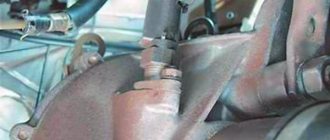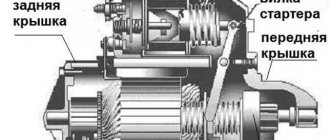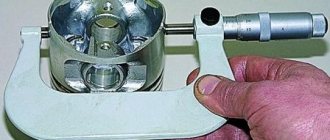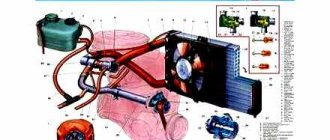Design and operation diagram of the interior heater of the VAZ 2114
During the cold season, the interior of the VAZ 2114 car is heated using a heater or stove. The basis of the stove is the radiator. Using a system of air ducts and dampers, the heat from it is directed to different areas of the cabin. This creates a microclimate that prevents the glass from freezing and provides comfortable conditions for the driver.
The stove in a VAZ 2114 car works on a fairly simple principle.
The heater operation scheme is quite simple. The heat source is a running engine, for cooling of which a special liquid is used - antifreeze. When the antifreeze moves in a vicious circle, heat is transferred from the hot motor to the cooling zones. There are two such zones in a passenger car - these are the radiators of the engine cooling system and the heater. Hot antifreeze transfers heat to cold air, which circulates through the radiator honeycombs using fans. Thus, the antifreeze cools down and returns to the engine, where it heats up again. This process must be continuous while the engine is running.
Stove radiator design
A car's heater consists of a housing with dampers and a metal radiator with pipes. Two types are installed: copper and aluminum. Each has its own advantages:
- Copper heaters have lower thermal conductivity, they heat up more slowly and also give off heat. Their reliability and maintainability are higher; the radiator can always be soldered.
- Aluminum is valued for its fast heating and good heat dissipation, low price and light weight. But if there is a leak, it is impossible to repair it.
Freshly unpacked heater radiator for Lada Kalina
Important! In a good stove radiator, plastic swirlers or turbulators are installed; they increase efficiency by 20-25%.
Frequent unit malfunctions:
- heating deteriorates due to clogged tubes and honeycombs;
- antifreeze leak;
- damp fog in the cabin due to leaky joints;
- cracks in the supply pipes.
These malfunctions are accompanied by a drop in the coolant level in the car's expansion tank and an increase in engine temperature. Most often, a leak reveals itself in winter during sudden temperature changes. Ethylene glycol vapors are toxic, so repairs should not be delayed.
Finding the stove on the Kalina is not difficult - it is located immediately behind the center console, slightly below the radio. The radiator size is 24 by 20 cm, thickness 5 cm. Immediately below it is installed the engine ECU, which is often filled with antifreeze in case of a serious leak.
Reasons for radiator failure:
- low quality antifreeze, the formation of scale and solid sediments in it, clogging the stove tubes;
- cheap types of antifreeze are aggressive to aluminum and lead to corrosion and cracks;
- low-quality products or counterfeits of well-known brands;
- water use in winter;
- destruction due to long-term use.
Design and reasons for replacing the stove radiator
The VAZ 2114 stove radiator has a simple but durable design. Its core consists of two rows of aluminum tubes and transverse thin metal plates that form a honeycomb. This ensures heat accumulation in the core. The ends of the tubes are flared in end plates and sealed with special materials. This ensures a tight fit of the mating surfaces. Three plastic tanks are welded to the ends of the core. Two tanks on one side are connected to the cooling system, and the third - on the opposite side - circulates antifreeze in the radiator.
The service life of the heater radiator is noticeably less than the service life of the car. Usually tubes, pipes, tanks begin to leak, or the core becomes clogged. For the VAZ 2114, heater radiators manufactured by DAAZ, Luzar, Pramo, Fenox, etc. are suitable, each of which has its own advantages and disadvantages.
What to consider when renovating
Do not forget that we check the correct operation of the internal heating system before assembling the instrument panel (dashboard). If, after the work has been done and the car’s heating system has started, in addition to the feeling of warmth inside the car, there are no drips or characteristic sounds of improper operation, then everything has been done correctly and successfully!
Important clarification. It is possible to replace the radiator of a VAZ 2114 stove only if it is copper or brass. Attempts to solder an aluminum radiator housing will most likely not lead to the desired result.
Choosing a new heater radiator
New cars of the VAZ family are equipped with heat exchangers from the Dimitrovgrad Automotive Component Plant. Their production uses technology from the French company VALEO (SOFICA).
The original heater radiator produced by DAAZ has small honeycombs
When purchasing a new radiator, the first things to consider are:
- frequency of installation of transverse plates;
- strength and rigidity of the plates;
- the presence of plastic swirlers in round aluminum tubes.
DAAZ radiators differ from their analogues in their tiny honeycombs, in which the transverse plates are located at a very small distance from each other. Due to this, the air remains in contact with the core for a long time and heats up more. The high rigidity of the plates does not allow them to deform under light impacts.
Purpose and design of the stove radiator
The main function of the stove radiator is to heat the interior during the cold season. A working heating system in frost conditions of -25˚C should maintain a temperature in the cabin of at least 16˚C. In addition, hot air passing through it and directed at the windows prevents them from fogging.
The heater radiator is designed to create a comfortable microclimate in the car interior
Design and location of the stove radiator
The vehicle interior heating system usually consists of a radiator connected to the engine cooling system, a motor with an impeller (fan), air ducts and a number of control and regulating elements. Space under the front panel is usually allocated for installing a radiator.
The stove works as follows. Hot antifreeze from the engine cooling system enters the heater radiator and heats it. The fan blows through the radiator honeycombs and supplies warm air into the cabin through the air duct system. By changing the fan rotation speed and the position of the dampers, you can regulate the temperature in the cabin.
The operation of the interior heater is based on the circulation of coolant through the heater radiator and heat extraction through a fan
Types of stove radiators
Stove radiators are classified according to various criteria. According to the material from which they are made, they are distinguished:
- aluminum;
- copper.
Despite the high heat transfer and the possibility of repair, copper radiators are rarely used. This is due to their high cost relative to aluminum products. Aluminum radiators, in addition to their low price, have less weight. However, when a leak occurs, such radiators most often have to be replaced with new ones.
Radiators are classified according to the shape of the tubes:
- with round tubes;
- with flat tubes.
Based on the density of the tubes, the radiator can be:
- two-row;
- three-row.
Three-row radiators are more efficient because they allow more liquid to pass through, increasing heat transfer.
What kind of service is this?
A malfunction in the coolant distribution system contributes to the leakage of antifreeze. The reasons are damage to hoses that are not securely fastened. In this case, repairing individual elements is irrational; replacing the heater radiator and replacing the radiator pipe will cost less.
The heater radiator ensures the flow of warm air into the vehicle interior and uses heat from the operating elements of the chassis. With the onset of cold weather, radiator failure is a common occurrence.
How does the repair work?
It is necessary to prepare the place through which the radiator is dismantled. The gas pedal is disconnected and the brake pedal is placed in the upper position. In order to avoid fine tuning of the steering column, it is removed:
- The polymer plate around the column is removed.
- The connectors from the switches, central ignition locks and power steering are removed.
- The steering column elements are disassembled into parts.
- The fasteners are unscrewed and the column is removed.
- The brake pedal goes up and the stop switch is pulled out at the same time. If this maneuver is difficult, use a lever.
- The brake and gas pedals are securely fixed in a raised position.
- This opens access to the faulty radiator, which can be easily removed.
- Assembly is carried out in reverse order.
The vehicle interior heating system includes a heater radiator and an electric fan. Without their proper operation, supplying warm air to the cabin is impossible. The heater core is located inside the instrument panel on the front passenger side, where the air conditioner radiator is replaced. The coolant coming from the engine passes through the heater core. The fan blows air through the heater core filled with hot coolant. The air absorbs the heat of the coolant and exits through the ventilation system deflectors. If the heater core becomes clogged or begins to leak, coolant circulation becomes poor. In this case, the heater does not work (the car interior does not heat up). A clogged or leaking heater core cannot be repaired. It needs to be replaced.
Methods for replacing the stove
If you suddenly decide to replace the radiator of the Lada Kalina stove with your own hands, then be prepared for minor difficulties. Car enthusiasts managed to simplify this process in the second way, without disassembling the instrument panel.
First, let's look at a more complex option:
- We take out the instrument panel;
- The electronic control unit was in plain sight. It must be removed to the side to avoid damage.
- The heater radiator is ready for dismantling.
The difficulty of this repair is that the instrument panel must be pulled out very carefully, otherwise it may break.
The second method, which has proven to be easier, is performed in the following order:
- Disconnect the negative terminal;
- Remove the steering wheel by unscrewing 4 bolts;
- Remove the pedal covers;
- The gas pedal must be depressed and the brake pedal must be turned off;
- Unscrew the pipes from the heater radiator;
- Remove the bottom part of the panel;
- If you change the heater radiator on Kalina with your own hands, you will have to work a little while removing the radiator itself. Some, making their work easier, cut it into two parts. This method is used to replace the radiator on many cars.
The technique of replacing a radiator is not much different in different brands of cars. When replacing the heater radiator with your own hands and on a Skoda Rapid, you will need the same tool and the replacement technique will also work.
The last step in replacing the radiator is to pour coolant into the expansion tank. To avoid an air lock in the system, it is necessary to loosen the clamp and remove the hose from the throttle assembly.
It is necessary to fill until coolant begins to flow out from the other end of the hose.
Removing the heater radiator
Removing a stove radiator is far from an easy process, and most often it is necessary to remove the instrument panel. But there is also a second method, an easier one, in which it is enough to pull out the glove compartment.
Most of the work related to replacing the heater radiator will be carried out at the top of the engine and inside the car. So repairs can be carried out without a pit and a jack.











